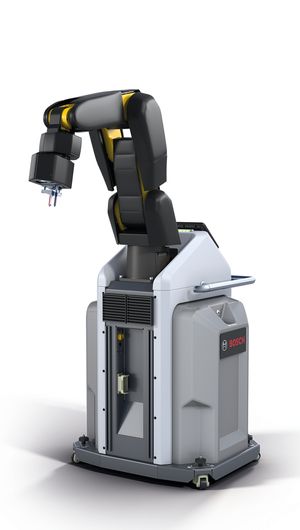KANBrief 1/18

Robots working in immediate proximity to human beings are regarded as a key step towards the networked, flexible factory of the future. Human-robot collaboration can relieve pressure upon production workers and enable companies to respond more quickly to the demands of the market. The robots' direct proximity to the human operative demands a high level of safety from the assistive systems; at the same time, it also offers potential for the inclusion of persons with disabilities.
Industry 4.0, termed the “fourth industrial revolution”, is intended as a response to fast-paced markets, shorter product life-cycles, and increasingly specific customer requirements. The factory of the future is however more than the networking of machines, installations and information technology alone: the intention is also for human beings to collaborate more closely with machines.
The breathtaking development of human-robot collaboration is born of the idea of combining the abilities of human beings and machines: working together, they achieve more than each would in isolation. Robots offer precision and stamina; human beings contribute their unique problem-solving abilities to the mix. Production processes can be managed more flexibly and smoothly as a result.
In industrial production, this works best when the two parties are able to interact directly as partners. In many scenarios however, this has still not been achieved: numerous industrial robots continue to be screened from human beings by steel cages or protective fences. However, robot systems are already available that have been developed specifically for direct collaboration with human beings and certified by the German Social Accident Insurance Institution for the woodworking and metalworking industries (BGHM) for collaborative use alongside human workers without supplementary protective devices.
A number of factors ensure that the human being and the robot interact safely. The robot uses an integral camera to grasp and place objects with a high degree of precision. Sensitive grippers feature pinch protection. In the event of a collision, the fingers of the gripper deflect, thereby protecting human beings against possible injury. One new development on the market is a capacitive sensor system that surrounds the robot arm and continually monitors its close environment. Should a person come too close to the robot, the latter stops working immediately, before contact is made. As soon as the person has retreated sufficiently far from the robot, it resumes its work at precisely the same point at which work was interrupted.
The extended long-range zone can also be monitored by means of a laser scanner. This enables robots to adapt their working speed flexibly depending upon whether human beings are in the vicinity. When this is not the case, they work at maximum speed. When a person enters the long-range zone, the machine automatically reduces the speed of its movements. Production assistants of this kind are now being used to great effect in several Bosch plants and in a range of other companies, including in the automotive industry.
In its AQUIAS project , conducted jointly with Fraunhofer IAO Stuttgart and ISAK gGmbH (a social firm for the integration of persons with disabilities), Bosch has been studying how collaborative robots can be used to support persons with a severe disability. Funding for the project is being provided by the German Federal Ministry of Education and Research (BMBF).
In conjunction with the German Social Accident Insurance Institutions for the woodworking and metalworking industries (BGHM) and the health and welfare services (BGW), a procedure has been developed in this project that extends traditional risk analysis to the risks particularly associated with collaborative work between robots and persons with disabilities. This comprehensive analysis of human beings and machines enables productive and safe workplaces to be designed for this group of persons. The division of labour between the human being and the service robot can be adjusted individually according to the nature of the disability and the need for support. Contact-free safety of the robot system constitutes a particular benefit in this context, from both a technical perspective and that of the human being, who is able to work safely and flexibly with the “sensitive robot colleague”.
Wolfgang Pomrehn
Product Manager, APAS Assistenzsysteme
Wolfgang.Pomrehn@de.bosch.com